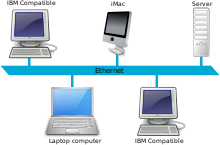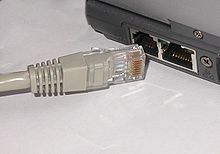Local area network
| Computer network types by scale |
|---|
 |

A local area network (LAN) is a computer network that interconnects computers within a limited area such as a residence, school, laboratory, university campus or office building.[1] By contrast, a wide area network (WAN) not only covers a larger geographic distance, but also generally involves leased telecommunication circuits.
Ethernet and Wi-Fi are the two most common technologies in use for local area networks. Historical network technologies include ARCNET, Token Ring and AppleTalk.
History
The increasing demand and usage of computers in universities and research labs in the late 1960s generated the need to provide high-speed interconnections between computer systems. A 1970 report from the
A number of experimental and early commercial LAN technologies were developed in the 1970s.
The development and proliferation of personal computers using the CP/M operating system in the late 1970s, and later DOS-based systems starting in 1981, meant that many sites grew to dozens or even hundreds of computers. The initial driving force for networking was to share storage and printers, both of which were expensive at the time. There was much enthusiasm for the concept, and for several years, from about 1983 onward, computer industry pundits habitually declared the coming year to be, "The year of the LAN".[10][11][12]
In practice, the concept was marred by the proliferation of incompatible
Of the competitors to NetWare, only
In 1983, TCP/IP was first shown capable of supporting actual defense department applications on a Defense Communication Agency LAN testbed located at Reston, Virginia.
During the same period,
, and other protocols used by the early PC LANs.In the 1980s, several token ring network implementations for LANs were developed.
Fiber Distributed Data Interface (FDDI), a LAN standard, was considered an attractive campus backbone network technology in the early to mid 1990s since existing Ethernet networks only offered 10 Mbit/s data rates and Token Ring networks only offered 4 Mbit/s or 16 Mbit/s rates. Thus it was a relatively high-speed choice of that era, with speeds such as 100 Mbit/s. By 1994, vendors included
Cabling

In 1979,
Early Ethernet (
While
Wireless media
In a
Technical aspects
Simple LANs generally consist of cabling and one or more
At the higher network layers, protocols such as NetBIOS, IPX/SPX, AppleTalk and others were once common, but the Internet protocol suite (TCP/IP) has prevailed as the standard of choice.
LANs can maintain connections with other LANs via leased lines, leased services, or across the Internet using virtual private network technologies. Depending on how the connections are established and secured, and the distance involved, such linked LANs may also be classified as a metropolitan area network (MAN) or a wide area network (WAN).
See also
References
- ^ Gary A. Donahue (June 2007). Network Warrior. O'Reilly. p. 5.
- ^ Samuel F. Mendicino (1970-12-01). "Octopus: The Lawrence Radiation Laboratory Network". Rogerdmoore.ca. Archived from the original on 2011-07-06.
- OSTI 4045588.
- ^ The History of Ethernet. NetEvents.tv. 2006. Retrieved September 10, 2011. Archived at Ghostarchive and the Wayback Machine
- ^ "Ethernet Prototype Circuit Board". Smithsonian National Museum of American History. 1973. Archived from the original on October 28, 2014. Retrieved September 2, 2007.
- ^ "A brief informal history of the Computer Laboratory". University of Cambridge. 20 December 2001. Archived from the original on 13 November 2010.
- ^ "ARCNET Timeline" (PDF). ARCNETworks magazine. Fall 1998. Archived from the original (PDF) on 2010-04-14.
- ^ Lamont Wood (2008-01-31). "The LAN turns 30, but will it reach 40?". Computerworld. Archived from the original on 2016-06-30. Retrieved 2016-06-02.
- ^ a b European Parliament Archives (January 25, 2021). "Voting system Tender Specifications - 1979". Archived from the original on June 16, 2021.
- ^ Metcalfe, Robert (Dec 27, 1993). "Will The Year of the ISDN be 1994 or 1995?". InfoWorld. 15 (52). Archived from the original on June 14, 2021. Retrieved June 14, 2021.
'The Year of The LAN' is a long-standing joke, and I freely admit to being the comedian that first declared it in 1982...
- ^ "Quotes in 1999". Cafe au Lait Java News and Resources. Archived from the original on 2016-04-14. Retrieved 2011-02-25.
...you will remember numerous computer magazines, over numerous years, announcing 'the year of the LAN.'
- ^ Herot, Christopher. "Christopher Herot's Weblog". Retrieved 2023-10-21.
...a bit like the Year of the LAN which computer industry pundits predicted for the good part of a decade...
- ^ Wayne Spivak (2001-07-13). "Has Microsoft Ever Read the History Books?". VARBusiness. Archived from the original on 2011-07-16.
- ^ Scott, W. Ross (May 1, 1984). "Updated Local Area Network Demonstration Plan". MITRE Corporation Working Paper (WP83W00222R1).
- ^ Havard (II.), Richard (17 June 1986). MITRENET: A Testbed Local Area Network at DTNSRDC. Ft. Belvoir Defense Technical Information Center: Defense Technical Information Center. p. i.
- ^ Scott, W. Ross; Cavedo, Robert F. (September 1, 1984). "Local Area Network Demonstration Procedures". MITRE Corporation Working Paper (WP83W00595).
- ^ Scott, W. Ross (August 1, 1984). "Local Area Network Alternative "A" Demonstration Analysis (DRAFT)". MITRE Corporation Working Paper (WP84W00281).
- ^ "Retro Isle - Acorn Econet". www.retroisle.com. Retrieved 2020-10-28.
- ^ "Chris's Acorns: Econet". chrisacorns.computinghistory.org.uk. Retrieved 2020-10-28.
- S2CID 30761524.
- ^ Pelkey, James. "14.18 Proteon in Chapter 14 - Internetworking: Emergence 1985-1988". The History of Computer Communications.
- ^ "IBM TOKEN-RING NETWORK". www-01.ibm.com. 1985-10-15. Retrieved 2021-03-11.
- ^ Crabb, Don (24 March 1986). "Major Vendors Differ On Network Approach". InfoWorld. Vol. 8, no. 12. p. 27.
- ^ "InfoWorld". 21 November 1988.
- ^ IEEE 802.3 Local Area Network considerations. IBM. GG22-9422-0.
- S2CID 52820607.
- ISBN 978-1-58705-119-7.
- ^ "IEEE Standards Association".
- S2CID 153804163. Archived from the original(PDF) on 2018-02-19.
- ^ Mark Miller (March 21, 1994). "Wading Through Plethora of Options Poses Challenge for Life on the Fast LAN". Network World. pp. 41, 44, 46–49. Retrieved August 15, 2013.
- ISBN 978-1-259-08220-7.
- ^ "Italian TV network RAI on the voting system". 25 January 2021. Archived from the original on 17 January 2023.
- ^ "Big pipe on campus: Ohio institutions implement a 10-Gigabit Ethernet switched-fiber backbone to enable high-speed desktop applications over UTP copper", Communications News, 2005-03-01, archived from the original on 2016-09-10,
As alternatives were considered, fiber to the desk was evaluated, yet only briefly due to the added costs for fiber switches, cables and NICs. "Copper is still going to be a driving force to the desktop for the future, especially as long as the price for fiber components remains higher than for copper."
- ^ "A Review of the Basic Components of a Local Area Network (LAN)". NetworkBits.net. Archived from the original on 2020-10-26. Retrieved 2008-04-08.
External links
 Media related to Local area networks (LAN) at Wikimedia Commons
Media related to Local area networks (LAN) at Wikimedia Commons
